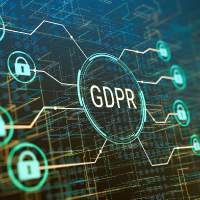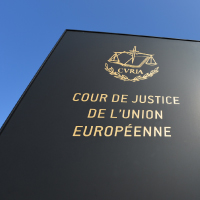
Recommended contact person
In 2025, privacy is more than a legal checkbox – it’s a competitive advantage. As cyber threats become more sophisticated and regulations tighten, protecting personal data is now at the core of every successful business strategy. But the question remains:
Are you truly safeguarding your data, or just ticking boxes?
As we look ahead to 2025, the intersection of GDPR compliance and cybersecurity is more crucial than ever. With Europe’s General Data Protection Regulation (GDPR) setting the gold standard for privacy protection, companies are under increasing pressure to keep up not only with the legal requirements but also with the rapidly evolving landscape of cyber threats. Gone are the days when a simple data breach would result in just reputational damage; today, the financial and legal implications could cripple a business.
Cybersecurity in 2025
According to the Ponemon Institute’s 2024 Cybersecurity Report, data breaches are no longer just accidental lapses; they are now targeted, calculated, and increasingly sophisticated. Cybercriminals in 2025 are leveraging cutting-edge technologies, including advanced artificial intelligence, machine learning, and even quantum computing, to penetrate conventional defences. As a result, outdated cybersecurity practices are no longer sufficient for GDPR compliance.
Consider this: Gartner’s 2024 Security Trends Survey reports that over 35% of companies previously deemed GDPR-compliant were flagged for insufficient cybersecurity measures by the end of 2024. This shortfall isn’t due to negligence but rather a failure to adapt to the increasing sophistication of cyber threats. In this rapidly evolving landscape, companies are confronted with a new imperative: only by integrating cybersecurity and GDPR compliance can they ensure comprehensive data protection.
GDPR demands more than just policies on paper. It requires proactive measures that ensure the integrity, confidentiality, and availability of personal data.
Here’s how businesses must adapt their approach:
- Conduct Regular Data Audits: Make transparency your priority. Regular audits help ensure data collection, storage, and processing align with GDPR and new cybersecurity standards.
- Embrace Data Minimization: Limit your data storage to essentials only. In 2025, excess data is a liability, making data minimization critical for reducing risk and liability.
- Adopt a Zero Trust Architecture: Implement a Zero Trust model, where every access request is verified, reducing vulnerabilities from internal and external threats.
- Secure Data with Encryption and Tokenization: Encrypt sensitive data at every stage—both in transit and at rest. This essential step makes unauthorized access significantly more challenging.
- Implement AI-Powered Cybersecurity Solutions: Use AI to detect anomalies and respond faster to potential threats, but ensure these systems align with GDPR data processing principles.
- Strengthen Access Control with Multi-Factor Authentication (MFA): Enhance security by requiring multiple verification methods, ensuring only authorized individuals have access to sensitive data.
- Create and Test Incident Response Plans: Prepare for potential breaches with a detailed, practiced incident response plan. Fast, organized responses can mitigate fines and protect your brand reputation.
- Regularly Train Employees on GDPR and Cybersecurity: Ensure employees understand their role in data protection, as human error remains one of the biggest risks to security.
- Collaborate with Third-Party Security Experts: Use trusted third-party experts for regular security assessments to identify and resolve vulnerabilities before they’re exploited.
- Build Consumer Trust with Transparent Data Practices: Prioritize transparency to earn consumer trust. Clear communication on data usage fosters loyalty and sets your business apart as a privacy-conscious leader.
Be Ready for 2025 as it is fast approaching, and the convergence of GDPR and cybersecurity demands a proactive approach. The businesses that will thrive in this environment are those that don’t just react to regulations but embrace them as part of their DNA. The future of data protection is already here – are you prepared to safeguard your personal data and your business?
Statistical Data:
Cybersecurity Breaches:
A 2024 study by the Ponemon Institute found that 43% of cyberattacks targeted small and medium-sized enterprises (SMEs), highlighting that even smaller businesses are not immune to sophisticated attacks. This emphasizes the need for robust security measures for companies of all sizes.
Cost of Data Breaches:
According to IBM’s 2024 Cost of a Data Breach Report, the global average cost of a data breach rose to $4.5 million, up from $4.24 million in 2023. The report stresses that breaches involving sensitive personal data often result in even higher costs, which could be mitigated with better compliance and security measures.
Zero Trust Adoption:
A Gartner 2023 survey on security trends reported that 60% of enterprises are either in the process of implementing or planning to implement a Zero Trust security model by 2025. The shift reflects the growing recognition of traditional perimeter defenses being inadequate for modern cyber threats.
Data Privacy and Consumer Trust:
In a Cisco 2024 Consumer Privacy Survey, 79% of respondents stated they would cease doing business with a company if it misused or mishandled their personal data. This data highlights the direct impact of strong data protection policies on customer retention and trust.
GDPR Fines:
The European Data Protection Board’s 2024 enforcement report revealed that GDPR fines have surpassed €2.9 billion since the regulation’s introduction, with a notable rise in penalties linked to insufficient cybersecurity practices. This trend shows that regulatory bodies are increasingly focused on ensuring organizations maintain proper data security alongside GDPR compliance.
Contact us today to learn more about how AGPLAW can help you at agp@agplaw.com
The information provided in this document/article is for general informational purposes only and should not be considered legal or professional advice. While every effort has been made to ensure the accuracy and reliability of the information contained herein, the author, publisher, or any related parties make no representations or warranties of any kind, express or implied, about the completeness, accuracy, reliability, suitability, or availability of the information. Any reliance you place on such information is therefore strictly at your own risk. In no event will the author, publisher, or any related parties be liable for any loss or damage, including without limitation, indirect or consequential loss or damage, or any loss or damage whatsoever arising from loss of data or profits arising out of, or in connection with, the use of this document/article. It is recommended to seek independent legal advice for any specific legal concerns or decisions.










